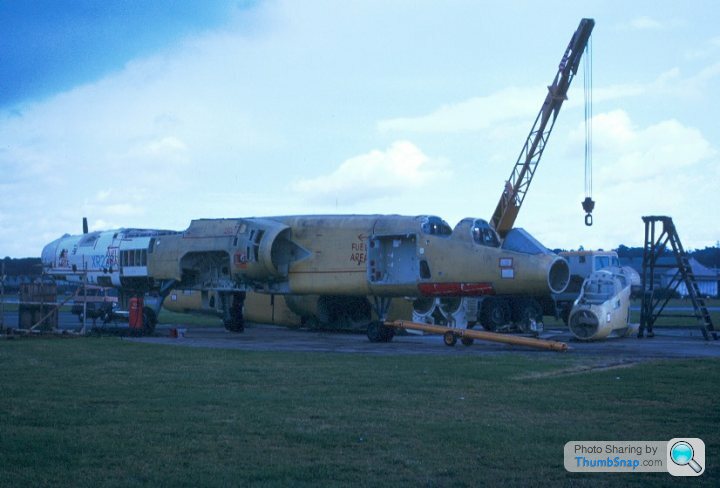50 years ago today at Boscombe Down...
Discussion
Ayahuasca said:
Are there any other fast jets whose two-seater training version is side by side?
Also the F102.I was told by former LIghtning pilot that the 2 seater actually performed better since the wider cockpit make it 'area ruled'. Which I think (Eric? Ginetta?) means that the cross section increases gradually rather than suddenly so it has less drag at high speed.
Edited by Dr Jekyll on Tuesday 7th October 20:32
'Area Rule' is to do with the change(s) in fuselage cross section and how it affects transonic flow, and specifically, the onset of Wave Drag.
Essentially an Area Ruled aircraft has a kind of 'coke bottle' shape - being 'pinched in' around the wing roots. Think Buccanneer.
The Lightning T4 (and hence later T5) came about really before the law of Area Rule was fulllly understood however, if you look at the fuselage cross section of the cockpit area you can see it is a sort of 'double bubble' shape. English Electric (BAC) achieved an Area Rule effect almost by accident.
It was certainly the case that the 'tubs' as the trainers were known had the equivalent performance to the single seaters. The major difference between a T5 and an F3 (for exampe) being that the former was heavier so had a higher fuel burn rate. Aside from that, from a performance point of view they were about the same.
Essentially an Area Ruled aircraft has a kind of 'coke bottle' shape - being 'pinched in' around the wing roots. Think Buccanneer.
The Lightning T4 (and hence later T5) came about really before the law of Area Rule was fulllly understood however, if you look at the fuselage cross section of the cockpit area you can see it is a sort of 'double bubble' shape. English Electric (BAC) achieved an Area Rule effect almost by accident.
It was certainly the case that the 'tubs' as the trainers were known had the equivalent performance to the single seaters. The major difference between a T5 and an F3 (for exampe) being that the former was heavier so had a higher fuel burn rate. Aside from that, from a performance point of view they were about the same.
Edited by Ginetta G15 Girl on Tuesday 7th October 21:26
In the mid to late 50s the side by side arrangement for two seaters was favoured for a number of designs e.g. -
the Provost and Jet Provost family
the A6 Intruder (and later Prowler) family
the F-111
the two seat Lightnings
the F-102 two seat variants
the Hunter two seaters
It was thought that having the two crew members side by side allowed them to monitor each other more effectively - especially useful on trainers.
However, there were aerodynamic compromises and later designs preferred the tandem arrangement. It is interesting that the two set version of the F-106 (the "new and improved F-102) was tandem rather than side by side.
the Provost and Jet Provost family
the A6 Intruder (and later Prowler) family
the F-111
the two seat Lightnings
the F-102 two seat variants
the Hunter two seaters
It was thought that having the two crew members side by side allowed them to monitor each other more effectively - especially useful on trainers.
However, there were aerodynamic compromises and later designs preferred the tandem arrangement. It is interesting that the two set version of the F-106 (the "new and improved F-102) was tandem rather than side by side.
T66ORA said:
Eric Mc said:
I`m pretty sure thats the same colour scheme as the Lightning on display at Boscombe Down main gate, i will check tomorrow while i`m in there. 
OT - I remember talking to the chaps designing the scheme at an open day, they were showing off their new graphics computer which cost 11,000 pounds at the time and which they'd used to trial different schemes. I don't think the gate guard scheme was anything to do with a particular squadron or anything.
As kids we used to ride up there on our bikes and play around the lightning, before it was behind the new gates.
Eric Mc said:
In the mid to late 50s the side by side arrangement for two seaters was favoured for a number of designs e.g. -
the Provost and Jet Provost family
the A6 Intruder (and later Prowler) family
the F-111
the two seat Lightnings
the F-102 two seat variants
the Hunter two seaters
It was thought that having the two crew members side by side allowed them to monitor each other more effectively - especially useful on trainers.
Not just 2 seaters. The B52 prototype had tandem seating for the pilots, production ones went over to side by side seating allegedly after the USAF looked at a Valiant and liked the idea.the Provost and Jet Provost family
the A6 Intruder (and later Prowler) family
the F-111
the two seat Lightnings
the F-102 two seat variants
the Hunter two seaters
It was thought that having the two crew members side by side allowed them to monitor each other more effectively - especially useful on trainers.
Ginetta G15 Girl said:
The T4 at Boscombe (the only surviving T4) is in the scheme it wore whilst at ETPS (Empire Test Pilots' School).
I have a vague recollection of a BBC series about the ETPS during the late 80s or maybe early 90s, and one of the planes I distinctly remembering the student pilots being tested on was the Lightning. It was the one they were all looking forward to flying. Must see whether I can find this series anywhere. Youtube is usually a good starting place!
Anyway, back to the original subject, to this day (over 30 years on) I vividly recall being taken to the museum at RAF Cosford and being blown away by the TSR2. It still looks striking even now.
telecat said:
ALthough the TSR2 was rated at MACH 2.35 in "Dash" mode. Its theoretical maximum speed was Mach 3 in level flight at 45,000 ft (14,000 m). I doubt the airframe would have taken that very often unless it was uprated.
The limitations are down to metallurgy. The types of alloy used for the airframe have structural limits imposed by operating temperature. The operating limit is related to the stagnation temperature of the operating Mach at altitude. In this case the limit was M2.25.Edited by telecat on Friday 3rd October 12:11
Given that similar alloys were used in Concorde and the Lightning they all have similar operational limits around M2.25
Even if the engines were uprated they couldnt increase the operational Mach limits without changing the metals used.
Dr Jekyll said:
Not just 2 seaters. The B52 prototype had tandem seating for the pilots, production ones went over to side by side seating allegedly after the USAF looked at a Valiant and liked the idea.
B-57 went the other way didn't it? Canberra (and B-57A) being side by side and the product 57 being tandem.Lurking Lawyer said:
I have a vague recollection of a BBC series about the ETPS during the late 80s or maybe early 90s, and one of the planes I distinctly remembering the student pilots being tested on was the Lightning. It was the one they were all looking forward to flying.
"Test Pilot". I have the book by Brian Johnson (the producer). Shown in 1987.https://www.youtube.com/watch?v=e9knSaT_4Tw
Found where I had heard the out-accelerating a Lightning cliam, it was on a documentary:
The full documentary (TSR2: the untold Story)
http://www.youtube.com/watch?v=o53u0X0Ik0w
Snippet with tale of Flight 14 here:
http://www.youtube.com/watch?v=GXdJxjvQZW4
The full documentary (TSR2: the untold Story)
http://www.youtube.com/watch?v=o53u0X0Ik0w
Snippet with tale of Flight 14 here:
http://www.youtube.com/watch?v=GXdJxjvQZW4
Fat Albert said:
Found where I had heard the out-accelerating a Lightning cliam, it was on a documentary:
The full documentary (TSR2: the untold Story)
http://www.youtube.com/watch?v=o53u0X0Ik0w
Snippet with tale of Flight 14 here:
http://www.youtube.com/watch?v=GXdJxjvQZW4
That documentary is littered with inaccuracies. And for those who think test pilots have the last word on accuracy, fast forward to 44:25 in where Roland Beamont explains how airframes were dragged out of the factory and burnt, particularly the magnesium parts which burnt "like a holocaust".The full documentary (TSR2: the untold Story)
http://www.youtube.com/watch?v=o53u0X0Ik0w
Snippet with tale of Flight 14 here:
http://www.youtube.com/watch?v=GXdJxjvQZW4
Only the footage shows a *wooden mockup* being burnt (many months after cancellation), not a single airframe was burnt, and the TSR2 had barely any magnesium parts...
Sadly, just like everybody else, old test pilots get confused and stories become ever more exciting with each successive recounting. Even Bea's books show confusion with his earlier ones being the better ones - he gets confused about which flight is which in some later volumes.
Lest we forget

One detail that is often forgotten, just how earth shatteringly LOUD this aircraft was.
If you ever heard Concorde out of Fairford in the very early days before they tried anything to quieten the Olympus engines you will have an idea.
Just fly it over the enemy at 50ft and M1.2 then dropping any payload would have added little extra....

One detail that is often forgotten, just how earth shatteringly LOUD this aircraft was.
If you ever heard Concorde out of Fairford in the very early days before they tried anything to quieten the Olympus engines you will have an idea.
Just fly it over the enemy at 50ft and M1.2 then dropping any payload would have added little extra....
Gassing Station | Boats, Planes & Trains | Top of Page | What's New | My Stuff





